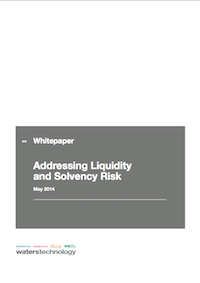
The last few years have made one idea crystal clear and unavoidable: Even smart and powerful firms can fail if they do not have their enterprise risk management
in top working order. They don’t just risk their own solvency; these risk-ignoring
firms can bring down their competitors and counterparties, as well as local and
even national economies. It wasn’t long ago that we witnessed a slew of global investment giants near collapse over the course of a few short weeks because their risk analytics, practices and/or controls were inadequate and in some cases, outright ignored. As a result, the industry as a whole is now focusing on updating its risk management and in particular credit, liquidity, and solvency risk management.
Governments and industry bodies have imposed new or revised regulations that
are aimed at controlling trading and risk practices with the goal of avoiding another liquidity crisis. With these new rules and philosophies driving change in all firms
on both business and IT levels, financial firms of all types have been overhauling their risk practices from top to bottom, by revising and implementing more comprehensive models and enterprise frameworks and by integrating their risk systems. However, making these changes is both complicated and expensive due to internal business barriers, technology challenges, and differing regulatory standards, such as the Dodd–Frank Act in the US and the European Market Infrastructure Regulation (EMIR). Clients need to be aware of what standards to adhere to when conducting business across borders, and meeting tight compliance deadlines.
With this in mind, IBM Platform Computing sponsored this WatersTechnology survey of IT professionals from two specific sectors of the financial services industry for their take on how they are responding to these changes. We surveyed professionals from the buy side and from insurance sectors in the summer of 2013. These two sectors were selected because while the liquidity crisis impacted firms of all types, the majority of the public’s focus has been and is on the sell side and its activities
in risk management. IBM Platform Computing and WatersTechnology wanted to understand how the other impacted sectors are responding in this area.
In the financial markets arena, the sell side has typically had deep pockets and invested in state-of-the-art technology to power its data and risk reporting tools. The buy side, on the other hand, historically received its IT and trading services from the sell side in exchange for commissions. But over the past few years, the buy side—from the smaller hedge funds and proprietary trading shops to the largest asset management firms—has become less dependent on sell side firms for their IT and trading services.
WatersTechnology surveyed insurers to understand the progress they have made
in the past few years in better managing their risk, especially their liquidity and solvency risk. Since the global liquidity crisis of 2008, we have seen calamities (Superstorm Sandy and floods in the US, tsunamis in the southern Pacific, and countless weather events around the globe) and regulation impact how insurers manage their risk. Insurers that were branded “too big to fail” continue to operate as-is despite initial outcries from politicians and pundits for changes. Could a too- big-to-fail firm fail today? Or if too-big-to-fail firms collapsed today, would they bring down entire economies with them?
All information that you supply is protected by our privacy policy. By submitting your information you agree to our Terms of Use.
* All fields required.




